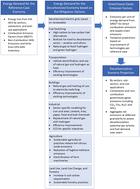当前位置:
X-MOL 学术
›
Sustain. Energy Fuels
›
论文详情
Our official English website, www.x-mol.net, welcomes your feedback! (Note: you will need to create a separate account there.)
A deep decarbonization framework for the United States economy – a sector, sub-sector, and end-use based approach
Sustainable Energy & Fuels ( IF 5.6 ) Pub Date : 2024-01-31 , DOI: 10.1039/d3se00807j Saurajyoti Kar 1 , Troy R. Hawkins 1 , George G. Zaimes 1 , Doris Oke 1 , Udayan Singh 1 , Xinyi Wu 1 , Hoyoung Kwon 1 , Shannon Zhang 1 , Guiyan Zang 1 , Yan Zhou 1 , Amgad Elgowainy 1 , Michael Wang 1 , Ookie Ma 2
Sustainable Energy & Fuels ( IF 5.6 ) Pub Date : 2024-01-31 , DOI: 10.1039/d3se00807j Saurajyoti Kar 1 , Troy R. Hawkins 1 , George G. Zaimes 1 , Doris Oke 1 , Udayan Singh 1 , Xinyi Wu 1 , Hoyoung Kwon 1 , Shannon Zhang 1 , Guiyan Zang 1 , Yan Zhou 1 , Amgad Elgowainy 1 , Michael Wang 1 , Ookie Ma 2
Affiliation

|
Achieving the United States' target of net-zero greenhouse gas emissions by 2050 will require technological transformations and energy sector mitigation. To understand the role of dynamically evolving technologies, identify synergies and dissonance and the effect of allocating limited low-carbon biomass resources in decarbonizing the U.S. economy, we developed the Decarbonization Scenario Analysis Model. A Life Cycle Assessment based approach is implemented considering the U.S. economy as the functional unit, to estimate greenhouse gas mitigation potential for projected energy demand based on several sector-level and cross-sectoral decarbonization pathways. Direct and supply-chain emissions are accounted, resulting from changes in patterns of energy generation and consumption, technology breakthroughs, and reductions in fugitive emissions over time at the granularity of economic sectors, sub-sectors, and end-use. Decarbonization strategies are implemented over a reference case developed using Energy Information Administration (EIA AEO) projection of economic activities for 2020–2050. Based on the considered scenarios, 80–90% economy-wide decarbonization relative to the 2020 reference case is projected. Electrification, low-carbon fuels, and reduction of fugitive emissions play the most significant role to decarbonization. The majority of the remaining emissions are accounted to the supply-chain and end-use emissions from natural gas and diesel fossil-based fuels in heavy duty transportation and heavy industries, highlighting the need for developing low-carbon and carbon-negative alternatives to mitigate those fossil-based carbon emissions.
中文翻译:

美国经济深度脱碳框架——基于部门、子部门和最终用途的方法
要实现美国到 2050 年温室气体净零排放的目标,需要进行技术转型和能源部门减排。为了了解动态发展的技术的作用,确定协同作用和不协调,以及分配有限的低碳生物质资源对美国经济脱碳的影响,我们开发了脱碳情景分析模型。将美国经济作为功能单元,采用基于生命周期评估的方法,根据多个部门层面和跨部门的脱碳路径来估计预计能源需求的温室气体减排潜力。能源生产和消费模式的变化、技术突破以及随时间推移以经济部门、分部门和最终用途为粒度的无组织排放减少所导致的直接排放和供应链排放均被计算在内。脱碳战略是根据能源信息管理局 (EIA AEO) 对 2020-2050 年经济活动的预测制定的参考案例来实施的。根据考虑的情景,相对于 2020 年参考案例,预计整体经济脱碳率为 80-90%。电气化、低碳燃料和减少无组织排放对脱碳发挥着最重要的作用。剩余排放量大部分来自重型运输和重工业中天然气和柴油化石燃料的供应链和最终用途排放,这凸显了开发低碳和负碳替代品来缓解排放的必要性。那些基于化石的碳排放。
更新日期:2024-01-31
中文翻译:

美国经济深度脱碳框架——基于部门、子部门和最终用途的方法
要实现美国到 2050 年温室气体净零排放的目标,需要进行技术转型和能源部门减排。为了了解动态发展的技术的作用,确定协同作用和不协调,以及分配有限的低碳生物质资源对美国经济脱碳的影响,我们开发了脱碳情景分析模型。将美国经济作为功能单元,采用基于生命周期评估的方法,根据多个部门层面和跨部门的脱碳路径来估计预计能源需求的温室气体减排潜力。能源生产和消费模式的变化、技术突破以及随时间推移以经济部门、分部门和最终用途为粒度的无组织排放减少所导致的直接排放和供应链排放均被计算在内。脱碳战略是根据能源信息管理局 (EIA AEO) 对 2020-2050 年经济活动的预测制定的参考案例来实施的。根据考虑的情景,相对于 2020 年参考案例,预计整体经济脱碳率为 80-90%。电气化、低碳燃料和减少无组织排放对脱碳发挥着最重要的作用。剩余排放量大部分来自重型运输和重工业中天然气和柴油化石燃料的供应链和最终用途排放,这凸显了开发低碳和负碳替代品来缓解排放的必要性。那些基于化石的碳排放。



























 京公网安备 11010802027423号
京公网安备 11010802027423号